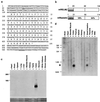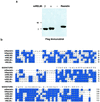A family of tissue-specific resistin-like molecules - PubMed (original) (raw)
Comparative Study
A family of tissue-specific resistin-like molecules
C M Steppan et al. Proc Natl Acad Sci U S A. 2001.
Abstract
We have identified a family of resistin-like molecules (RELMs) in rodents and humans. Resistin is a hormone produced by fat cells. RELMalpha is a secreted protein that has a restricted tissue distribution with highest levels in adipose tissue. Another family member, RELMbeta, is a secreted protein expressed only in the gastrointestinal tract, particularly the colon, in both mouse and human. RELMbeta gene expression is highest in proliferative epithelial cells and is markedly increased in tumors, suggesting a role in intestinal proliferation. Resistin and the RELMs share a cysteine composition and other signature features. Thus, the RELMs together with resistin comprise a class of tissue-specific signaling molecules.
Figures
Figure 1
Identification and characterization of RELMα. (a) Predicted amino acid sequences of murine and rat RELMα. Identical amino acids are indicated, conservative substitutions are indicated by +, and conserved cysteine residues are shaded. (b) Schematic comparison of murine RELMα, rat RELMα, and murine resistin predicted amino acid sequences. Percent identity is indicated. (c and d) Northern blot analysis of RELMα gene expression in various mouse tissues (c) and a comparison of 3T3-L1 adipocytes and mouse white adipose tissue (WAT) (d). Ethidium bromide staining of 28S and 18S RNA is shown in each case.
Figure 2
RELMβ is an intestine-specific resistin-like molecule. (a) Murine RELMβ cDNA and protein sequences. In-frame upstream stop codon and putative polyadenylation sequence are underlined. Cysteine residues are indicated in bold, and the downstream stop codon is indicated by *. (b) Comparison of murine RELMβ and murine resistin predicted amino acid sequences. Percent identity is indicated. (c) Northern blot analysis of RELMβ gene expression in the mouse. 28S and 18S RNA is shown below to demonstrate loading of similar amounts of RNA (20 μg per lane). (d) Northern analysis of human RELMβ mRNA in multiple human tissues.
Figure 3
RELMβ is expressed in proliferative intestinal epithelia. (a) Northern analysis of RELMβ mRNA levels in mouse intestine. β-actin hybridization is shown as control for loading. (b) Northern analysis of RELMβ mRNA during mouse embryogenesis. (c and d) In situ hybridization of serial sections of mouse colon probed with RELMβ antisense (c) and sense (d) probes. Positive staining is dark blue. (e) Northern analysis of RELMβ in normal appearing small intestine (N) and adjacent tumors (T) in a min mouse. 28 and 18S RNA is shown as loading control. A representative of three independent experiments is shown.
Figure 4
The RELM family of secreted proteins. (a) RELMs are secreted proteins. RELMβ, RELMα, and resistin were fused to Flag epitope at C terminus and expressed in 293T cells. Media was sampled and analyzed by immunoblot using Flag antibody. − indicates control vector. (b) Consensus sequence of the RELM family. Blue shading indicates amino acid identity of two or more family members, aligned by
dnastar megalign
program using the Jotun Hein method. The signature sequence characteristic of the RELMs is indicated.
Similar articles
- Serum concentrations of resistin-like molecules beta and gamma are elevated in high-fat-fed and obese db/db mice, with increased production in the intestinal tract and bone marrow.
Shojima N, Ogihara T, Inukai K, Fujishiro M, Sakoda H, Kushiyama A, Katagiri H, Anai M, Ono H, Fukushima Y, Horike N, Viana AY, Uchijima Y, Kurihara H, Asano T. Shojima N, et al. Diabetologia. 2005 May;48(5):984-92. doi: 10.1007/s00125-005-1735-1. Epub 2005 Apr 15. Diabetologia. 2005. PMID: 15834545 - Comparative studies of resistin expression and phylogenomics in human and mouse.
Yang RZ, Huang Q, Xu A, McLenithan JC, Eisen JA, Shuldiner AR, Alkan S, Gong DW. Yang RZ, et al. Biochem Biophys Res Commun. 2003 Oct 24;310(3):927-35. doi: 10.1016/j.bbrc.2003.09.093. Biochem Biophys Res Commun. 2003. PMID: 14550293 - Dimerization of resistin and resistin-like molecules is determined by a single cysteine.
Banerjee RR, Lazar MA. Banerjee RR, et al. J Biol Chem. 2001 Jul 13;276(28):25970-3. doi: 10.1074/jbc.M103109200. Epub 2001 May 17. J Biol Chem. 2001. PMID: 11358969 - Adiponectin and resistin--new hormones of white adipose tissue.
Bełtowski J. Bełtowski J. Med Sci Monit. 2003 Feb;9(2):RA55-61. Med Sci Monit. 2003. PMID: 12601307 Review. - Resistin-like molecules: a marker, mediator and therapeutic target for multiple diseases.
Shi Y, Zhu N, Qiu Y, Tan J, Wang F, Qin L, Dai A. Shi Y, et al. Cell Commun Signal. 2023 Jan 23;21(1):18. doi: 10.1186/s12964-022-01032-w. Cell Commun Signal. 2023. PMID: 36691020 Free PMC article. Review.
Cited by
- Metabolic syndrome and insulin resistance: underlying causes and modification by exercise training.
Roberts CK, Hevener AL, Barnard RJ. Roberts CK, et al. Compr Physiol. 2013 Jan;3(1):1-58. doi: 10.1002/cphy.c110062. Compr Physiol. 2013. PMID: 23720280 Free PMC article. Review. - Role of Adipose Tissue Hormones in Pathogenesis of Cryptoglandular Anal Fistula.
Włodarczyk M, Włodarczyk J, Maryńczak K, Waśniewska-Włodarczyk A, Doboszewska U, Wlaź P, Dziki Ł, Fichna J. Włodarczyk M, et al. Int J Mol Sci. 2024 Jan 25;25(3):1501. doi: 10.3390/ijms25031501. Int J Mol Sci. 2024. PMID: 38338780 Free PMC article. - The Role of Adipokines in the Control of Pituitary Functions.
Kaminska B, Kurowicka B, Kiezun M, Dobrzyn K, Kisielewska K, Gudelska M, Kopij G, Szymanska K, Zarzecka B, Koker O, Zaobidna E, Smolinska N, Kaminski T. Kaminska B, et al. Animals (Basel). 2024 Jan 22;14(2):353. doi: 10.3390/ani14020353. Animals (Basel). 2024. PMID: 38275812 Free PMC article. Review. - Resistin-like molecule α promotes pathogenic Th17 cell responses and bacterial-induced intestinal inflammation.
Osborne LC, Joyce KL, Alenghat T, Sonnenberg GF, Giacomin PR, Du Y, Bergstrom KS, Vallance BA, Nair MG. Osborne LC, et al. J Immunol. 2013 Mar 1;190(5):2292-300. doi: 10.4049/jimmunol.1200706. Epub 2013 Jan 25. J Immunol. 2013. PMID: 23355735 Free PMC article. - Obesity-associated cancer risk: the role of intestinal microbiota in the etiology of the host proinflammatory state.
Djuric Z. Djuric Z. Transl Res. 2017 Jan;179:155-167. doi: 10.1016/j.trsl.2016.07.017. Epub 2016 Jul 28. Transl Res. 2017. PMID: 27522986 Free PMC article. Review.
References
- Steppan, C. M., Bailey, S. T., Bhat, S., Wright, C. M., Brown, E. J., Banerjee, R. R., Ahima, R. S. & Lazar, M. A. (2001) Nature (London), in press. - PubMed
- Chawla A, Schwarz E J, Dimaculangan D D, Lazar M A. Endocrinology. 1994;135:798–800. - PubMed
- Yang H, Jiang W, Furth E E, Wen X, Katz J P, Sellon R K, Silberg D G, Antalis T M, Schweinfest C W, Wu G D. Am J Physiol. 1998;275:G1445–G1453. - PubMed
- Williams L, Bell L. Embryology. 1991;183:573–578. - PubMed
Publication types
MeSH terms
Substances
LinkOut - more resources
Full Text Sources
Other Literature Sources
Molecular Biology Databases



